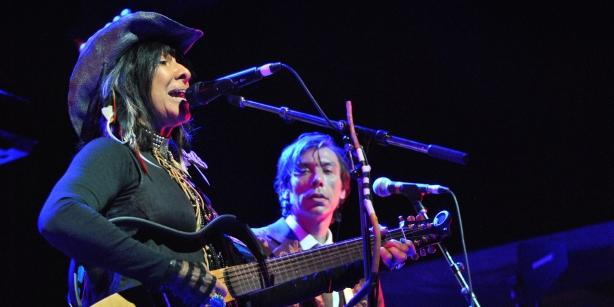 Music
Music
Hillside Festival's big heart a win for the underdog
by Tom Beedham
July 30, 2016
Guelph’s annual Hillside Festival remains Canada's radical alternative
Ever since it relocated from its original base at the Riverside Park Band Shell in 1987, Guelph, Ontario’s Hillside Festival has been a three-day, not-for-profit celebration that annually invites a few thousand festival-goers to spend a weekend with stellar bands, artists, local vendors, volunteers, and other community members, all within the bounds of a low-impact festival village sprawling across conservation space on Guelph Lake Island, completely void of corporate presence.
But since Bonnaroo co-producer AC Entertaintainment and Republic Live announced its 40,000-person capacity commercial mega festival co-venture WayHome Music & Arts Festival would take place throughout the same weekend just 90 minutes up the highway, Hillside has also spent the last two years dealing with a decline in ticket sales.
Flying in the face of all this, Hillside returned this year with three stacked days of performances from acts like Canadian music legend Buffy Sainte-Marie, Jennifer Castle, Pup, Casey Mecija, Suuns, Nap Eyes, Land of Talk, and Un Blonde; spoken word and a poetry slam; workshops focused on skill- and community-building; and children’s activities. So I skipped on WayHome’s VIP packages and branded activations, packed up my camping bag, hopped on a Greyhound (and, after that, a festival shuttle bus), set up a tent in Volly Village (Hillside’s affectionately named camping area for the festival’s 1,300 volunteers, performers, and media alike), and dug into the schedule.
Heading first to the festival’s Island Stage – one of the two large tented stages located on either side of the island – I started my weekend with a workshop performance that had Fond of Tigers’s Jesse Zubot and Skye Brooks collaborating with Son Little and Stephen Lyons.
While Hillside doesn’t have the budget for seven-figure headliners like Neil Young or Kendrick Lamar, it reaches beyond the status quo set by other similarly sized festivals by focusing on delivering radical performances from newer, smaller names.
Concert workshops, which position festival performers opposite others they often will not meet until arriving on the island (and in some cases, don’t even speak the same languages as them) create new, unparalleled performances and cross-cultural interactions that are seldom repeated in any other contexts (improvisation abounds). These co-operative jams epitomize the Hillside experience, and since watching Sonic Youth’s Lee Ranaldo and Steve Shelley, and Arcade Fire’s Richard Reed Parry, Colin Stetson, and Sarah Neufeld close out my first Hillside weekend with one of these sets in 2013, they’ve been my favourite part of the festival. So before the end of the night, passing on taking in a set from Ought in favour of another workshop between Esmerine and Xylouris White wasn’t such a tough call.
Watching Esmerine’s chamber rock collide with George Xylouris and Jim White’s tradition-exploding lute and drums combo for 45 minutes is a mezmerising new experience, and when they reach Dalmak’s climactic “Barn Board Fire,” a couple of shirtless toddlers charge the space in front of the stage and erupt into a frenzy of dance and friendly wrestling. Onstage, Esmerine marimbist Bruce Cawdron’s young son has the best seat in the house, and during the band’s own set the next day he’ll even join them in performing, adding some plunky xylophone to a hushed music box sound; not only does Hillside’s all-ages approach do a good job of quashing cynicism, it encourages new generations to connect with old.
Speaking over the phone two days after the festival, Hillside artistic director Samir Baijal tells me he’s been approaching the festival with younger generations in mind since he started programming Hillside in 1998.
“No matter what, 18 years later, I’m still saying the same thing,” Baijal says. “You’ve got to respect your past – your foundations and your ethical sensibilities – and you’ve also got to be looking at the present and what’s relevant, and you’ve got to be looking ahead. If you’re not doing that, you’re basically digging your own grave.”
“You can’t be stuck in a time warp,” he says. And in the face of an event landscape that’s seen an increasing number of festivals crowd Southern Ontario calendars over the past four years, that’s especially crucial.
Baijal says the current situation has been difficult to maneuver. After selling out the festival consistently since 2005, attendance was down about 15 per cent last year, and this year Hillside saw about 30 per cent less guests. That’s translated to moving 2017’s festival from its regular fourth weekend in July to the July 14-16 weekend. But beyond making that adjustment, Baijal doesn’t forecast much change in the way Hillside plans future events, insisting the key is to keep the brand strong.
“It’s not about trying to compete with something you can’t compete against,” he says. “I tried to program this year’s festival in a way that is no different than any other one.”
As a result, he says, “this year’s programming I think really did reflect kind of what Hillside is known for, and it seemed to please a lot of the old school people.”
It’s by embracing a holistic commitment to engaging with heritage and the oncoming future, Marie Zimmerman says, that Hillside was able to facilitate important intergenerational and intercultural conversations at this year’s festival. As Hillside’s executive director, she’s responsible for ensuring that all of the festival’s programming meets Hillside’s mission to promote creative expression, independence, equality, altruism, environmentalism, and peace making.
The festival’s Aboriginal Circle, which has been sponsored and coordinated by members of Guelph’s aboriginal community since it was established as a part of Hillside in 1999, called for critical discussions oriented toward ongoing community issues. While some workshops emphasized the importance of community-based dispute settlements, others dealt directly with the vocabulary surrounding 2015’s Truth and Reconciliation Report.
Zimmerman says Hillside challenges audiences to engage with these issues because they affect us all.
“In the larger community and culture, we have all heard about the Truth and Reconciliation Report,” she says over the phone. “We have all heard about what we all need to be accountable for, and it’s a part of our history as people who live on this soil that we need to recognize.”
As a result, they also informed concert programming directly.
“Because she does promote truth telling and culture keeping as part of her music, we felt that there was an incredible alignment between Buffy Sainte-Marie’s work and what we try to do at Hillside and what the Aboriginal Circle tries to do,” Zimmerman says.
At the main stage, I closed my festival standing next to young children and adults more than twice my age watching Saint-Marie dig into unrecorded material from last year’s Polaris Music Prize winning Power in the Blood, and deeper cuts I remember hearing from Sesame Street reruns, reimagined here with the help of the Sadies.
Technically, the land mass at the centre of the reservoir Hillside holds its annual festival on is a peninsula, not an island – and neither is Hillside. And from the time you arrive (via shuttle bus or bicycle) to volunteers greeting your wristbands with a “Happy Hillside” at the entrance, you know this to be true: unlike most other festivals in Southern Ontario, Hillside is meaningfully in sync with the world around it, actively working to establish bonds and strengthen relationships between its many moving parts. It’s a way of life, and if this year’s edition proved anything, they won’t stop.
Tags: Music, Festival, Festival Season, Hillside Festival, WayHome









